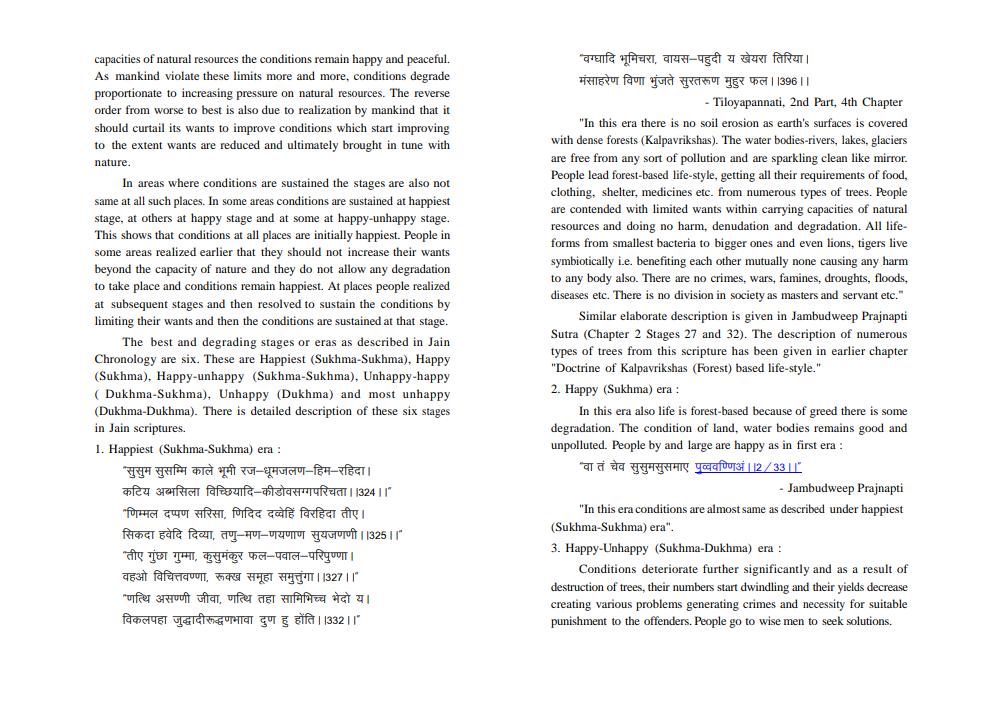________________
capacities of natural resources the conditions remain happy and peaceful. As mankind violate these limits more and more, conditions degrade proportionate to increasing pressure on natural resources. The reverse order from worse to best is also due to realization by mankind that it should curtail its wants to improve conditions which start improving to the extent wants are reduced and ultimately brought in tune with nature.
In areas where conditions are sustained the stages are also not same at all such places. In some areas conditions are sustained at happiest stage, at others at happy stage and at some at happy-unhappy stage. This shows that conditions at all places are initially happiest. People in some areas realized earlier that they should not increase their wants beyond the capacity of nature and they do not allow any degradation to take place and conditions remain happiest. At places people realized at subsequent stages and then resolved to sustain the conditions by limiting their wants and then the conditions are sustained at that stage.
The best and degrading stages or eras as described in Jain Chronology are six. These are Happiest (Sukhma-Sukhma), Happy (Sukhma), Happy-unhappy (Sukhma-Sukhma). Unhappy-happy (Dukhma-Sukhma), Unhappy (Dukhma) and most unhappy (Dukhma-Dukhma). There is detailed description of these six stages in Jain scriptures. 1. Happiest (Sukhma-Sukhma) era:
14 TAHI TU-Hula-HETI afcu starfi fafesuifa- T RUTT | 1324 || "णिम्मल दप्पण सरिसा, णिदिद दब्वेहिं विरहिदा तीए। Reci gafe Pean, - - YouTutoft 1325
तीए गुंछा गुम्मा, कुसुमंकुर फल-पवाल-परिपुण्णा। 26311 fafar out, 49 HET TY1327 "णत्थि असण्णी जीवा, णस्थि तहा सामिभिच्च भेदो य। famelyet yaGUTACI gu g xifat | 13321"
'वग्धादि भूमिचरा, वायस-पहुदी य खेयरा तिरिया। HTETUT PUUTSU TE 5139611
- Tiloyapannati, 2nd Part, 4th Chapter "In this era there is no soil erosion as earth's surfaces is covered with dense forests (Kalpavrikshas). The water bodies-rivers, lakes, glaciers are free from any sort of pollution and are sparkling clean like mirror. People lead forest-based life-style, getting all their requirements of food, clothing. shelter, medicines etc. from numerous types of trees. People are contended with limited wants within carrying capacities of natural resources and doing no harm, denudation and degradation. All lifeforms from smallest bacteria to bigger ones and even lions, tigers live symbiotically i.e. benefiting each other mutually none causing any harm to any body also. There are no crimes, wars, famines, droughts, floods, diseases etc. There is no division in society as masters and servant etc.
Similar elaborate description is given in Jambudweep Prajnapti Sutra (Chapter 2 Stages 27 and 32). The description of numerous types of trees from this scripture has been given in earlier chapter "Doctrine of Kalpavrikshas (Forest) based life-style." 2. Happy (Sukhma) era:
In this era also life is forest-based because of greed there is some degradation. The condition of land, water bodies remains good and unpolluted. People by and large are happy as in first era: ar da
yogafou 31|2/33l
- Jambudweep Prajnapti "In this era conditions are almost same as described under happiest (Sukhma-Sukhma) era". 3. Happy-Unhappy (Sukhma-Dukhma) era:
Conditions deteriorate further significantly and as a result of destruction of trees, their numbers start dwindling and their yields decrease creating various problems generating crimes and necessity for suitable punishment to the offenders. People go to wise men to seek solutions.




